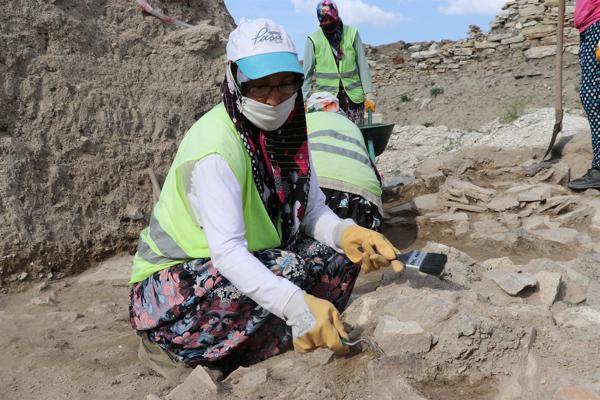Women shed light on history in mound
KÜTAHYA


Women working in the rescue excavations that have been carried out in Seyitömer Mound in the western province of Kütahya have contributed to the unearthing of the 5,000-year-old historical remains.
The excavations, which were initiated in 1989 in order to bring the coal under the mound into the economy, have been carried out for two years by the Kütahya Museum Directorate under the presidency of the museum’s Deputy Director Serdar Ünan.
Forty women, who have been working in the excavations, helped history come to light with great care and devotion.
The scientific advisor of the study, Dumlupınar University (DPU) academic Nazan Ünan told the state-run Anadolu Agency that the work on the mound was one of the largest rescue excavations projects in Turkey.
Ünan explained that this year they have planned to find the continuation of the Early Bronze Age layers and the Roman Period settlement during the excavations that started in May.
Stating that women have been employed in the excavation works, Ünan said, “This year, we started working with 50 staff, including 250 workers, archaeologists, anthropologists, restorers, architects, architectural restorers and ceramics experts. Forty of the employees are women. Some of the women work in the excavation house, the other in the field. We are very pleased with the women workers. Because they work in harmony with each other and they are very compatible with the team. They also show performance.”
Ünan stated that the women workers were from the city center and surrounding villages.
Stating that those who worked last year will continue to work this year as well, Ünan said, “Women carefully approach it when they unearth a find. We can see the sensitivity of an archaeologist in our women.”
She said that women have also opened the finds by using fine tools such as trowels, brushes and dental tools.
Stating that they trust them, Ünan said, “With the guidance of our archaeologists, they open the finds, sweep and clean them. If needed, they lift stones like male workers.”
Meryem Cik stated that she has been working in the rescue excavation since last year. She said that by working, they both contributed to the family budget and learned about the Antiquity.
“When we come to the mound in the morning, we wonder what to find that day. We are working with the guidance of our instructors here. We get excited and very happy when we find items belonging to ancient times. We ask questions about the ancient artifacts we have found. Excavating in the mound is a great experience for us.”
Another woman, Mevlüde Tekin, said that the excavations were fun and made them happy to find historical artifacts.
Fadime Kayacan, the owner of three grandchildren, stated that they have contributed to the history by working in the mound.
Seyitömer Mound
Seyitömer Mound, which dates back to 3,000 B.C., is located in the Çelikler Seyitömer Elektrik Üretim AŞ work area, 26 kilometers away from the city center.
The rescue excavation on the mound, the original height of which was 26 meters, width 140 and length 150 meters, was initiated by Eskişehir Museum Directorate in 1989 in order to bring 12 million tons of lignite under it into the economy.
The mound was excavated by the Afyonkarahisar Museum Directorate between the years 1990 and 1995. The excavations got transferred to the DPU Archeology Department in 2006.
The excavation team consisting of academic staff, students and workers continued working under the presidency of the head of the department, Professor Nejat Bilgen until 2014. More than 17,000 artifacts excavated from the mound have been handed over to the Museum Directorate for display.
The excavations have been resumed by a team led by Serdar Ünan after four years.
